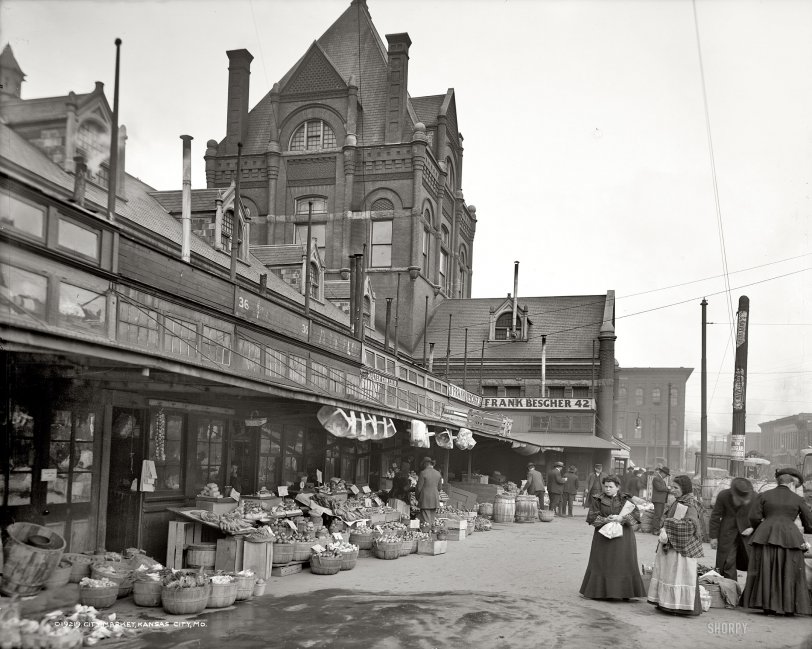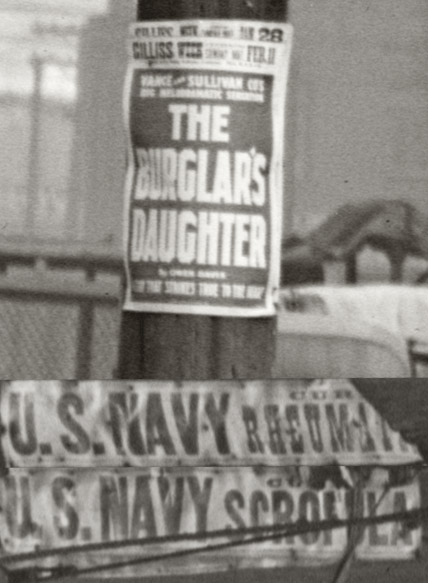


Framed or unframed, desk size to sofa size, printed by us in Arizona and Alabama since 2007. Explore now.
Shorpy is funded by you. Patreon contributors get an ad-free experience.
Learn more.

- Baldwin 62303
- Baldwin VO-1000
- Cold
- No expense spared
- Tough Guys
- Lost in Toyland
- And without gloves
- If I were a blindfolded time traveler
- Smoke Consumer Also Cooks
- Oh that stove!
- Possibly still there?
- What?!?
- $100 Reward
- Freeze Frame
- Texas Flyer wanted
- Just a Year Too Soon
- WWII -- Replacing men with women at the railroad crossing.
- Yes, Icing
- You kids drive me nuts!
- NOT An Easy Job
- I wonder
- Just add window boxes
- Icing Platform?
- Indiana Harbor Belt abides
- Freezing haze
- Corrections (for those who care)
- C&NW at Nelson
- Fallen Flags
- A dangerous job made worse
- Water Stop
Print Emporium
City Market: 1906

Circa 1906. "City Market, Kansas City, Missouri." 8x10 inch dry plate glass negative, Detroit Publishing Company. View full size.
You Are Here
This picture appears to have been taken from 5th and Walnut Street looking north. In this Sanborn Fire Map, note the Market House and City Hall. The best clue is the road that is on the right side of the picture. Based on the map, it can only be Walnut Street.
We have a framed print of this pic in our home. We live at 2nd and Walnut (Old Townley Lofts) in the River Market area of KC. The current City Market is bounded by 3rd & 5th Street and Grand & Main.
We love Shorpy.com and our print. It is like a little time machine that takes us 105 years into the past.
JP Carter
K.C., MO
Can I help you, Miss?
I'll take a bushel of red apples, a peck of potatoes, and a hug around the neck.
The Burglar's Daughter, or a True Heart Wins Friends
This 1899 children's book by Margaret Penrose was made into a musical, and there is a film short from 1908. The sign likely is for the musical.
Bananas by the bunch
The "Gros Michel" (Big Mike) variety of bananas which were sold during this period were less fragile and traveled better than the Cavendish variety commonly imported now. (Supposedly, they were also bigger, sweeter and, well, more banana-y.) The Gros Michel was harvested and shipped by the several-foot bunch, and held in climate-controlled ships and railroad cars until arrival at the local wholesaler, where they were trimmed off the trunk into the smaller "hands" displayed at the grocer's. Winter shipping would have been relatively inexpensive, due to less need for icing the refrigerator cars and the lack of domestic produce haulage.
The Gros Michel variety was wiped out by Panama Disease by the 1960s, and cultivation was switched to the Cavendish. Possibly apocryphally, the disease caused a temporary shortage in the 1920s and led to the song "Yes! We Have No Bananas."
Yes we have no bananas
Bananas had actually been available for a few decades by 1906. When they were first being imported in the 1870's, they were indeed very expensive: 10 cents each, which is what a poor man might earn working all day. They were consumed as a delicacy.
By the end of the century though, they were sufficiently cheap to have worked themselves into popular culture and consciences. The age old gag of slipping on a banana peel is much more than 100 years old.
Locavores beware
As a produce grower just west of KC I had figured the photo for sometime in October, so the Burglar's Daughter comment was nice corroboration. What interests me, however, is how little local food there really was ... at a time when produce is abundant. Only the bananas appear to have been shipped in from away.
Starting from the left there are a few sweet potatoes (just to the right of the barrel), loads of leeks or possibly green onions (both of which grow very well in autumn around here), and what I think might be radishes just to the left of the door. There's one small basket of Irish potatoes, and a braid of garlic (which would have been harvested in early July).
Moving to the fruit stand there are some excellent pears, loads of apples, and (most interestingly) a few bunches of grapes. Eastern Kansas and western Missouri used to be prime orchard country and in the early 20th Century apples would have sold for about 25 cents for an eight-quart basket (=quarter bushel, or around ten pounds). This vendor also has a few sweet potatoes.
Most of the other stands are about the same, though there might be a few bunches of carrots at one. The main potato vendor is to be seen between the two women -- he's counting his money -- and his crop has probably been in underground storage since July. Many farmers grew potatoes along the Kansas River valley and after harvest would store them in spring-cooled buildings cut slightly into the bedrock on the south side of the valley (thereby facing north).
A farmer just south of us had his own siding on the A.T.& S.F. for shipping barrels of potatoes into this market, and the ruins of his potato buildings are still there.
Paper or plastic?
Willow, please, with a nice big handle.
City Market at Fifth & Walnut
has been there since 1857. It looks kinda the same as it did in 1906 but is larger and I guess somewhat nicer. In the 1970s it was part of an entertainment area then known as the River Quay. Restaurants, Bars, Music, Fun. As it turned out it was heavily owned by the Mafia who had turf battles with explosives.
The River Quay is no more, but the area is now thriving with the City Market as an important anchor. Among interesting attractions is the Arabia Museum which has the largest collection of pre-Civil War artifacts in the world.
Some Useful Links Are:
Crime Magazine
City Market Website
Arabia Steamboat Museum
Everything has always been up to date in Kansas city.
Bananas for Sale
I can't help but notice the large pile of bananas for sale. Were they quite expensive at this time, being rather fragile and shipped over long distances?
Could it be the West Bottoms?
What a great photo! Having lived in KC now for about 20 years, I am of course trying to place this scene in the context of what buildings currently remain in the River Market from this time. Many things have changed -- obviously -- but this scene looks more like the West Bottoms area of KC to me. Could it be?
The Burglar's Daughter
Can't make out the small text of the flyer on the pole to the right but the melodrama, "The Burglar's Daughter" opened on Broadway September 17, 1906. Already advertised in KC when this was taken.
[Plus two other interesting handbills -- "U.S. NAVY CURES RHEUMATIC FEVER" and "U.S. NAVY CURES SCROFULA." Where do I enlist? - Dave]

























On Shorpy:
Today’s Top 5